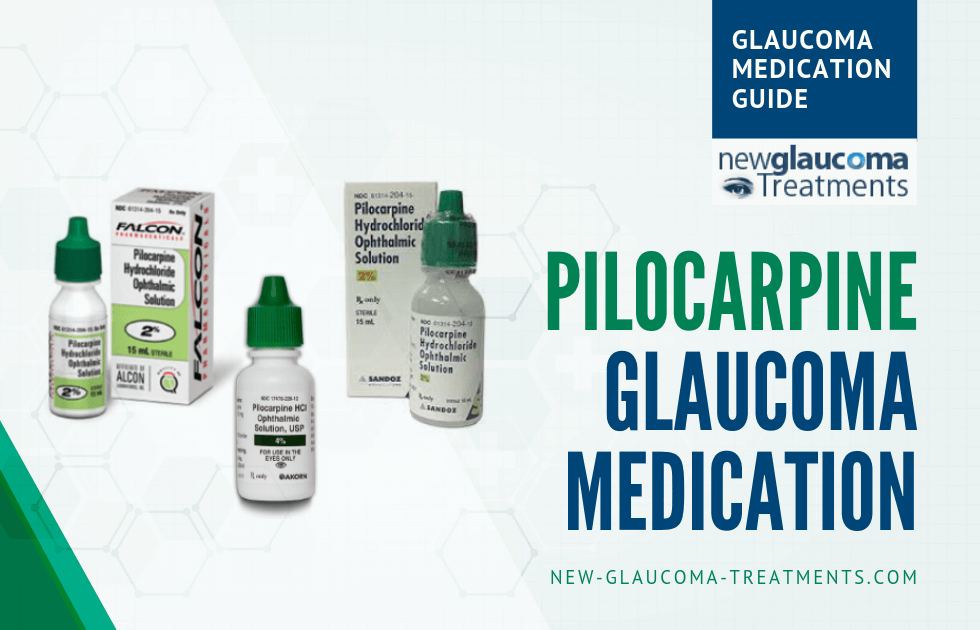A Patient’s Guide to Glaucoma Medications

Pilocarpine Medication for Glaucoma
How it works:
Pilocarpine is a miotic agent which means it constricts the pupil. As the pupil constricts it pulls on the trabecular meshwork, stretching it open. This results in increased flow of aqueous fluid through the eye’s natural drainage system[1].
How well does it work:
It can work well, though it is not as effective as timolol[2]. Additionally, there is a large percentage of patients who simply cannot tolerate the side effects.
Commonly prescribed:
Pilocarpine is available in multi-use bottles in concentrations ranging from 0.5% to 6% (1%, 2%, and 4% are the most commonly prescribed concentrations).
Cap color:
Green
Note about Preservative-Free options:
Most prescription eye drops have a preservative which keeps bacteria from growing in the bottle. However, the most commonly used preservative, Benzalkonium chloride (BAK), can worsen dry eye and may even be toxic to the trabecular meshwork over time. Given that the trabecular meshwork is already not functioning well in most forms of glaucoma, I generally prefer to prescribe preservative-free versions of glaucoma eye drops when available and affordable. Unfortunately, Pilocarpine is not commercially available in a preservative-free form.
How it is taken:
Unfortunately, pilocarpine has to be taken four times a day (which is about every four waking hours)[3]. Hardly anyone I know can keep that up long-term. Fortunately, there is some evidence that it may still be effective when taken only twice daily (as least when combined with nasolacrimal duct occlusion)[4].
Note on Fixed Combinations:
None available in the USA
Side effects:
Eye-Specific Side Effects
- Tearing
- Eye ache, brow ache
- Decreased vision at night an in low light settings (due to small pupil)
- Increased risk of retinal detachment (highest risk in those who are nearsighted)[5]
- Change in refractive error (more nearsighted)
- Not all is bad: reading vision in good light generally improves (also due to the small pupil which results in a pinhole camera effect)
Systemic Side Effects[6]
- Diaphoresis (sweating)
- Salivation
- Nausea, vomiting, diarrhea, cramping
- Bronchospasm (difficulty breathing)
- Abnormal heart rhythm
- Cognitive depression (at least in those with dementia)[7]
How to minimize side effects:
Start with a low dose 0.5% or 1% and work up to 4%
Interactions with other medications:
- Pilocarpine reduces uveoscleral outflow so would potentially cancel out at least part of the IOP lowering effect of the prostaglandin analog class of medications[8]. Due to this reason (as well as other Pilocarpine-specific issues) these two classes are rarely prescribed together.
When might these be prescribed?
Due to the side-effect profile, dosing frequency, interaction with the commonly prescribed prostaglandin analog class, and high cost, Pilocarpine is rarely prescribed today. It’s most common modern use is primarily limited to prior to laser surgery for narrow angles.
Cost?
Given that this medication has been FDA approved for decades you’d think it would be cheap, right? And a few years ago you would have been right. For reasons I cannot explain, however, Pilocarpine is now quite expensive: often over $200 a bottle.
If you are prescribed this medication and it is not covered by your insurance or even with insurance coverage it’s quite expensive then I recommend you search out a good cash price through the website “GoodRx”. I frequently recommend this site to my patients and have been surprised at how much they can often save on certain classes of medications despite not using their insurance.
Summary:
Although Pilocarpine is one of the few IOP lowering medications that works at the source of the problem in glaucoma (the trabecular meshwork) it’s high cost, often intolerable side effects, and need to use it four times daily make it a poor choice for most active people with glaucoma.
References:
[1] Grierson I, Lee WR, Abraham S. Effects of pilocarpine on the morphology of the human outflow apparatus. Br J Ophthalmol. 1978;62(5):302–313.
[2] Vogel R, Crick RP, Mills KB, et al. Effect of timolol versus pilocarpine on visual field progression in patients with primary open-angle glaucoma. Ophthalmology. 1992;99(10):1505–15.
[3] Drance SM, Bensted M, Schulzer M. Pilocarpine and intraocular pressure. Duration of effectiveness of 4 percent and 8 percent pilocarpine instillation. Arch Ophthalmol.1974;91(2):104–106.
[4] Zimmerman TJ, Sharir M, Nardin GF, et al. Therapeutic index of pilocarpine, carbachol, and timolol with nasolacrimal occlusion. Am J Ophthalmol. 1992;114(1):1–7.
[5] Beasley H, Fraunfelder FT. Retinal detachments and topical ocular miotics. Ophthalmology. 1979;86(1):95–98.
[6] Greco JJ, Kelman CD. Systemic pilocarpine toxicity in the treatment of angle closure glaucoma. Ann Ophthalmol. 1973;5(1):57–59.
[7] Reyes PF, Dwyer BA, Schwartzman RJ, et al. Mental status changes induced by eye drops in dementia of the Alzheimer type. J Neurol Neurosurg Psychiatry. 1987;50(1):113–115.
[8] Crawford K, Kaufman PL. Pilocarpine antagonizes prostaglandin F2alpha-induced ocular hypotension in monkeys. Evidence for enhancement of uveoscleral outflow by prostaglandin F2 alpha. Arch Ophthalmol. 1987;105(8):1112–1116
Related Articles:
- Medical Therapy for Glaucoma: Nitric Oxide Donators
- Medical Therapy for Glaucoma: Prostaglandin Analogs
- Medical Therapy for Glaucoma: Carbonic Anhydrase Inhibitor (CAI) Eye Drops
- Medical Therapy for Glaucoma: Carbonic Anhydrase Inhibitor – Systemic Treatment
- Medical Therapy for Glaucoma: Alpha-Agonists
- Medical Therapy for Glaucoma: Beta-blockers

David Richardson, MD
Medical Director, San Marino Eye
David Richardson, M.D. is recognized as one of the top cataract and glaucoma surgeons in the US and is among an elite group of glaucoma surgeons in the country performing the highly specialized canaloplasty procedure. Morever, Dr. Richardson is one of only a few surgeons in the greater Los Angeles area that performs MicroPulse P3™ "Cyclophotocoagulation" (MP3) glaucoma laser surgery. Dr. Richardson graduated Magna Cum Laude from the University of Southern California and earned his Medical Degree from Harvard Medical School. He completed his ophthalmology residency at the LAC+USC Medical Center/ Doheny Eye Institute. Dr. Richardson is also an Ambassador of Glaucoma Research Foundation.


